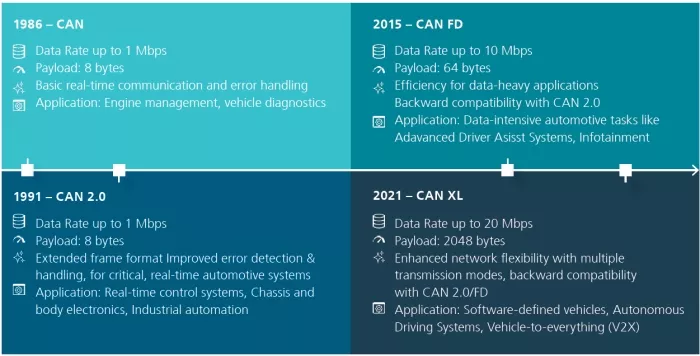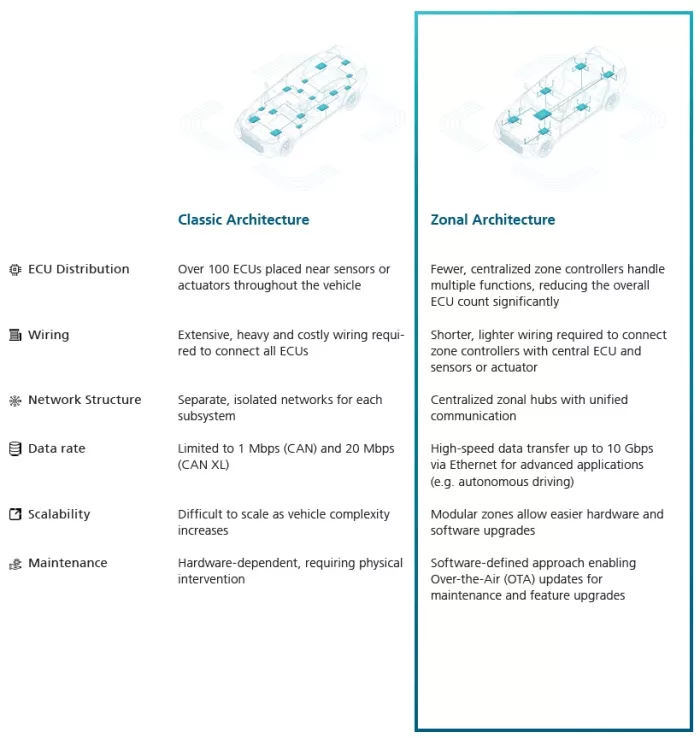Automotive IP-Cores: Evolution and Future Perspectives
By Fraunhofer IPMS
Introduction
The automotive industry is undergoing a significant transformation, driven by advancements in technology and evolving consumer demands. In this context, the development of automotive IP-Cores plays a crucial role in enhancing communication and control systems within vehicles. This whitepaper explores established systems like CAN and LIN, and highlights new developments in Ethernet technologies, including zonal architectures and emerging standards like 10BASE-T1S.
CAN – Controller Area Network & LIN – Local Interconnect Network
CAN, introduced in the 1980s by Bosch, is a key automotive communication standard known for its robustness and functionality, especially in critical systems like engine management and safety. Over the years, it has evolved with improved data rates. LIN, developed as a low-cost alternative for non-critical applications, operates as a sub-network to CAN for body control functions, utilizing a simple master-slave model and supporting data rates up to 20 kbps with full CAN interoperability.

Advantages of CAN
- High reliability and fault tolerance
- Real-time data transmission
- Reduced wiring harness weight and cost
- Supports multiple nodes on the same bus
- Supports point-to-multipoint communication
- Well-established standard
Advantages of LIN
- Designed for low-traffic/low-cost applications
- Simplified wiring harness
- Easy to implement and integrate
- Master-slave architecture simplifies communication
- Suitable for non-critical applications
New Development: “Ethernetification” & Zonal Architecture
Ethernet is becoming the backbone of automotive networks, driven by the demand for higher bandwidth to support advanced driver-assistance systems (ADAS) and infotainment. Zonal architecture organizes electronic components into functional areas, enhancing modularity and scalability. This design facilitates the integration of communication protocols like Ethernet, CAN, and LIN. Ethernet enables high-speed data transfer for advanced applications, while CAN handles real-time, critical functions. LIN complements CAN for simpler, non-critical tasks, offering a cost-effective solution. Overall, this architecture enhances vehicle performance and addresses the growing complexity of modern automotive systems.

Key Advantages of Ethernet for Automotive Application in Zonal Architecture
- Performance: Supports advanced real-time applications with faster data transfer rates and network reliability
- Modularity & Scalability: Easily integrates new technologies and features
- Cost Efficiency: Reduces wiring complexity and reduces ECU count by moving software processing into CPU
- Unified Communication: Standardizes protocols for better interoperability
- Future Proof: Enables software driven vehicles with significantly higher data rates far beyond 10G and easy updates over the air for any vehicle related software
New Developments to Refine Automotive Ethernet Concept
10BASE-T1S (Single Pair ethernet)
A recent development in Ethernet technology, 10BASE-T1S allows for a single twisted pair cable to carry data, reduce weight and complexity while supporting speeds of up to 10 Mbps. Unlike traditional point-to-point Ethernet links, it supports point-to-multipoint communication on a shared cable. With these features, it succeeds the CAN infrastructure for connecting sensors and actuators in in-vehicle networks, as protocol bridging is no longer necessary when integrating them into a centralized Ethernet backbone architecture.
TSN (Time Synchronization Networking)
Time-Sensitive Networking (TSN) adds on top of this as it is a set of IEEE standards designed to enhance Ethernet networks by providing deterministic and low-latency communication. TSN enables the synchronization of data transmission, ensuring that time-critical data packets are delivered within strict time limits. This is particularly important in automotive applications, such as advanced driver-assistance systems (ADAS) and autonomous driving, where timely data exchange is crucial for safety and performance.
About Fraunhofer IPMS
The Fraunhofer Institute for Photonic Microsystems IPMS stands for applied research and development in the fields of Smart Industrial Solutions, Bio and Health, Mobility as well as Green and Sustainable Microelectronics. Research focuses on electronic, mechanical and optical components and their integration into miniaturized devices and systems. The range of services extends from design and product development to pilot production in its own laboratories and clean rooms.
As an expert in secure data communication solutions, the business unit of Data Communication and Computing (DCC) develops innovative technologies in the future-oriented fields of IP cores, Li-Fi (light-based data transmission) and quantum technologies. These developments pave the way for new and secure communication solutions in key industries such as mobility, telecommunications, industrial automation and energy supply.
Contact
Stephan Kube
B2B Sales Marketing Manager
+49 351 88 23 - 1211
stephan.kube@ipms.fraunhofer.de
Fraunhofer IPMS
Maria-Reiche-Straße 2
01109 Dresden, Germany
www.ipms.fraunhofer.de/
Related Semiconductor IP
- CAN XL Verification IP
- Protocol controller IP for Classical CAN / CAN FD / CAN XL
- Protocol controller IP for Classical CAN / CAN FD / CAN FD light commander and CAN XL
- Verification IP for CAN XL, FD and CAN 2.0
- CAN XL Controller IP
Related Articles
- Driving the Future of Automotive Infotainment with Noise Resilient Audio Converters
- The Future of Safe and Secure Aerospace Systems
- Role of Embedded Systems and its future in Industrial Automation
- Evolution of VLSI Technology and its Applications
Latest Articles
- A 14ns-Latency 9Gb/s 0.44mm² 62pJ/b Short-Blocklength LDPC Decoder ASIC in 22FDX
- Pipeline Stage Resolved Timing Characterization of FPGA and ASIC Implementations of a RISC V Processor
- Lyra: A Hardware-Accelerated RISC-V Verification Framework with Generative Model-Based Processor Fuzzing
- Leveraging FPGAs for Homomorphic Matrix-Vector Multiplication in Oblivious Message Retrieval
- Extending and Accelerating Inner Product Masking with Fault Detection via Instruction Set Extension